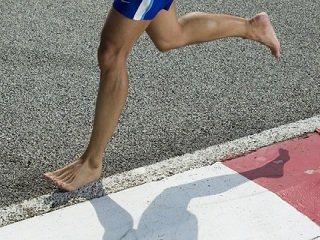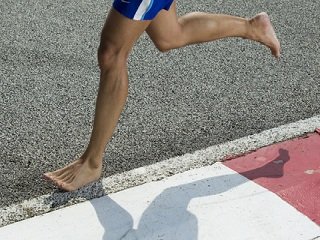 While it’s been practiced worldwide for many years, minimalist—and even barefoot—running has seen a surge in popularity recently. As research spotlights the natural physicality of the activity, companies have produced impressive shoes for the sport, including Five Fingers and the Minimus. If you’ve taken an interest in minimalist/barefoot running, it’s important to take a few steps to make sure it’s right for you before jumping in feet first. Here are a few tips to help you get started on the right foot.
While it’s been practiced worldwide for many years, minimalist—and even barefoot—running has seen a surge in popularity recently. As research spotlights the natural physicality of the activity, companies have produced impressive shoes for the sport, including Five Fingers and the Minimus. If you’ve taken an interest in minimalist/barefoot running, it’s important to take a few steps to make sure it’s right for you before jumping in feet first. Here are a few tips to help you get started on the right foot.
Perhaps the most important step in making the transition into minimalist/barefoot running is making sure to start slowly. Not everyone will be capable of engaging in the sport successfully, depending on various potential physical conditions, such as tendonitis, bunions, or flat feet. In fact, it’s best for everyone to check with a doctor beforehand to make sure they’re physically able to give minimalist running a try.
Once you decide to try minimalist or barefoot running, the first step is getting your feet used to the activity. A great way to do this is to simply stand on gravel while barefoot. This will prepare your feet by toughening their soles. Next, try walking around barefoot and then after some time, work up to a jog using the proper stride. Once you can do this, then it’s time to switch to a run on grass, dirt, or a beach.
Minimalist/barefoot running requires a different stride than conventional running, which I learned the hard way when I first started. Practice landing on the middle of your foot, rather than the heel. Your heel can make contact, but it’s important for your midfoot to do so first. For first timers, this can create stiffness in your Achilles tendon, simply because the muscles in your aches will be weak—you’ve most likely never used them like this before—and you’ll be relying on your calf muscles more. Make sure to use a short stride and maintain a quick, steady cadence with the strike of your foot, making sure to lift your foot rather than push off like you normally would.
Once you get the hang of this new stride and technique, it’s time to incorporate it into your running schedule. Be sure to start slowly, though. Build up to normal and gradually increase your distance over time. You don’t want to do too much too soon, so it’s important to build endurance and strength in your muscles by slowly pushing them a bit at a time.
As I’ve said, be sure to consult a doctor concerning your physical condition, especially your feet and legs, to make sure you’ll be able to safely perform the activity, and be sure to start things slowly once you do. Odds are, this is new territory for you, so be smart, stretch before and after running, and listen to your body. Barefoot and minimalist running can be extremely fun and rewarding once you’ve taken the steps to ensure you know what you’re doing.








